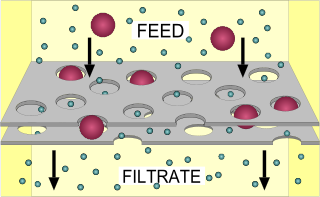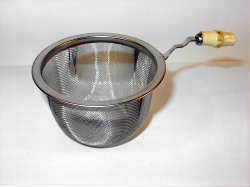
Filtration is a physical separation process that separates solid matter and fluid from a mixture using a filter medium that has a complex structure through which only the fluid can pass. Solid particles that cannot pass through the filter medium are described as oversize and the fluid that passes through is called the filtrate. Oversize particles may form a filter cake on top of the filter and may also block the filter lattice, preventing the fluid phase from crossing the filter, known as blinding. The size of the largest particles that can successfully pass through a filter is called the effective pore size of that filter. The separation of solid and fluid is imperfect; solids will be contaminated with some fluid and filtrate will contain fine particles. Filtration occurs both in nature and in engineered systems; there are biological, geological, and industrial forms. In everyday usage the verb "strain" is more often used; for example, using a colander to drain cooking water from cooked pasta.

In cooking, a consommé is a type of clear soup made from richly flavoured stock or broth that has been clarified, a process that uses egg whites to remove fat and sediment.

A water filter removes impurities by lowering contamination of water using a fine physical barrier, a chemical process, or a biological process. Filters cleanse water to different extents, for purposes such as: providing agricultural irrigation, accessible drinking water, public and private aquariums, and the safe use of ponds and swimming pools.
A disc filter is a type of water filter used primarily in irrigation, similar to a screen filter, except that the filter cartridge is made of a number of plastic discs stacked on top of each other like a pile of poker chips. Each disc is covered with small grooves or bumps. The discs each have a hole in the middle, forming a hollow cylinder in the middle of the stack. The water passes through the small passages in between and the impurities are trapped behind.

A colander is a kitchen utensil perforated with holes used to strain foods such as pasta or to rinse vegetables. The perforations of the colander allow liquid to drain through while retaining the solids inside. It is sometimes called a pasta strainer. A sieve, with much finer mesh, is also used for straining.

A kitchen hood, exhaust hood, hood fan, extractor hood, or range hood is a device containing a mechanical fan that hangs above the stove or cooktop in the kitchen. It removes airborne grease, combustion products, fumes, smoke, heat, and steam from the air by evacuation of the air and filtration. In commercial kitchens exhaust hoods are often used in combination with fire suppression devices so that fumes from a grease fire are properly vented and the fire is put out quickly. Commercial vent hoods may also be combined with a fresh air fan that draws in exterior air, circulating it with the cooking fumes, which is then drawn out by the hood.

A mesh is a barrier made of interlaced strands of metal, fiber or other flexible or ductile materials. A mesh is similar to a web or a net in that it has many interwoven strands.

Sand filters are used as a step in the water treatment process of water purification.

A chinois, also known as a bouillon strainer, is a conical sieve with an extremely fine mesh. It is used to strain custards, purees, soups, and sauces, producing a very smooth texture. It can also be used to dust food with a fine layer of powdered ingredient.

An oil filter is a filter designed to remove contaminants from engine oil, transmission oil, lubricating oil, or hydraulic oil. Their chief use is in internal-combustion engines for motor vehicles, powered aircraft, railway locomotives, ships and boats, and static engines such as generators and pumps. Other vehicle hydraulic systems, such as those in automatic transmissions and power steering, are often equipped with an oil filter. Gas turbine engines, such as those on jet aircraft, also require the use of oil filters. Oil filters are used in many different types of hydraulic machinery. The oil industry itself employs filters for oil production, oil pumping, and oil recycling. Modern engine oil filters tend to be "full-flow" (inline) or "bypass".

A tamis is a kitchen utensil, shaped somewhat like a snare drum, that acts as a strainer, grater, or food mill. A tamis has a cylindrical edge, made of metal or wood, that supports a disc of fine metal, nylon, or horsehair mesh. To use one, the cook places the tamis above a bowl and adds the ingredient to be strained in the centre of the mesh. The food is then pushed through using a scraper or pestle. Tamises have been in use since the Middle Ages.

A sieve analysis is a practice or procedure used in geology, civil engineering, and chemical engineering to assess the particle size distribution of a granular material by allowing the material to pass through a series of sieves of progressively smaller mesh size and weighing the amount of material that is stopped by each sieve as a fraction of the whole mass.

In soil science, soil gradation is a classification of a coarse-grained soil that ranks the soil based on the different particle sizes contained in the soil. Soil gradation is an important aspect of soil mechanics and geotechnical engineering because it is an indicator of other engineering properties such as compressibility, shear strength, and hydraulic conductivity. In a design, the gradation of the in situ soil often controls the design and ground water drainage of the site. A poorly graded soil will have better drainage than a well graded soil, if it is not high in clay quality.
Mechanical screening, often just called screening, is the practice of taking granulated or crushed ore material and separating it into multiple grades by particle size.
Black powder is an industry name for the abrasive, reactive particulate contamination present in all gas and hydrocarbon fluid transmission lines. Black powder ranges from light brown to black, and the mineral makeup varies per production field around the world.
A sieve is a tool to separate materials of one characteristic from materials of another.
Maize miller is the processing of maize (corn) for safe and palatable consumption as food. Processing can be by machine-milling in either large- or small-scale mills, or by hand-milling in domestic or community settings.
Tumbler screening is a separation method that uses three-dimensional elliptical movement to separate very fine particles from larger ones.
A circle-throw vibrating machine is a screening machine employed in processes involving particle separation. In particle processes screening refers to separation of larger from smaller particles in a given feed, using only the materials' physical properties. Circle throw machines have simple structure with high screening efficiency and volume. However it has limitations on the types of feed that can be processed smoothly. Some characteristics of circle-throw machines, such as frequency, vibration amplitude and angle of incline deck also affect output.
Gyratory equipment, used in mechanical screening and sieving is based on a circular motion of the machine. Unlike other methods, gyratory screen operates in a gentler manner and is more suited to handle fragile things, enabling it to produce finer products. This method is applicable for both wet and dry screening.













